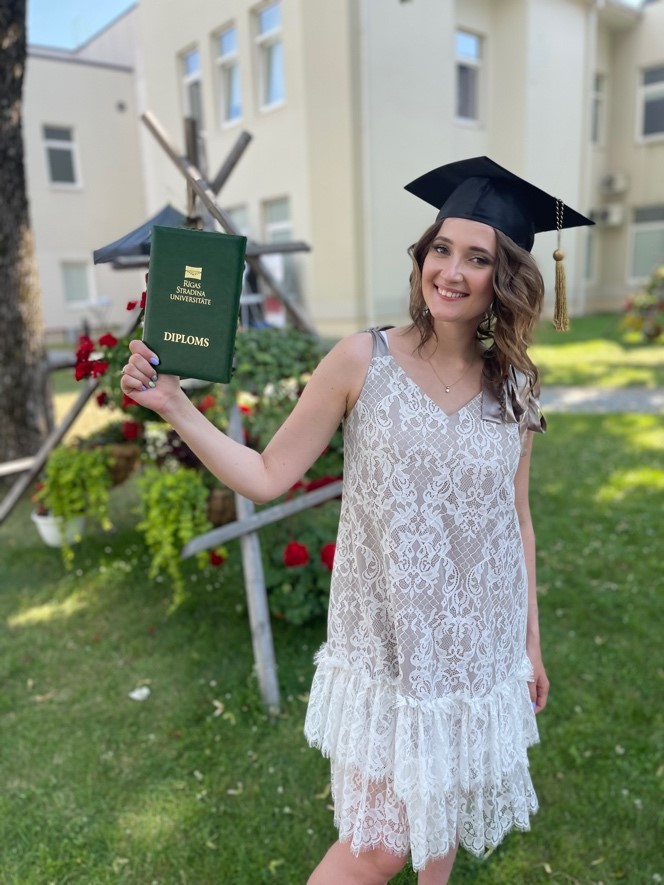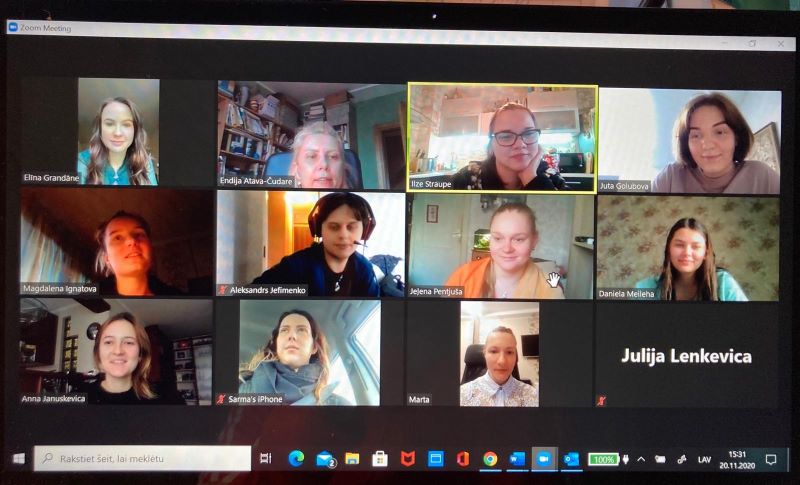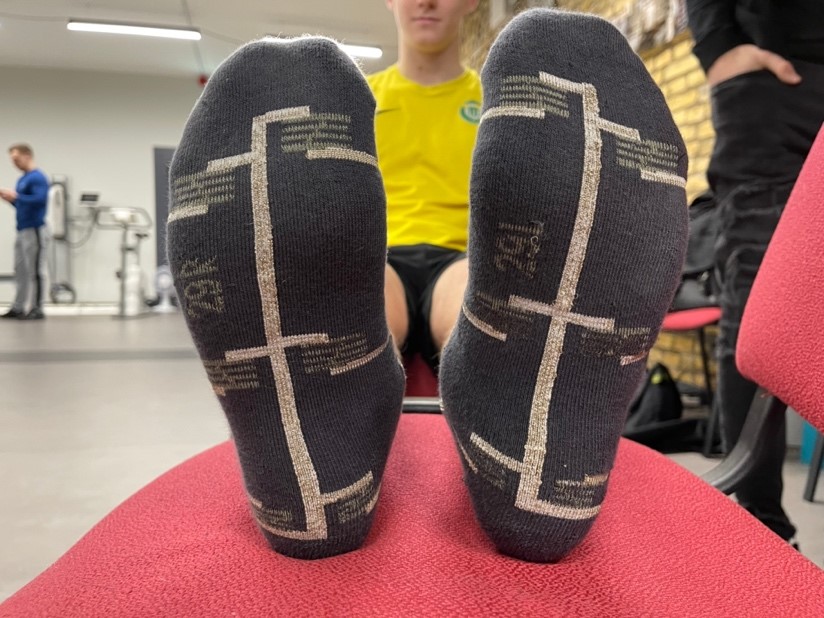RSU graduate and ‘smart socks’ researcher Anna Davidoviča: master’s studies are about exciting research
‘Master’s studies give you a broader perspective on your profession,’ says Anna Davidoviča, who is currently a certified physiotherapist at the traumatology and orthopaedics clinic Orto. She is a graduate of the Rehabilitation master’s programme at Rīga Stradiņš University (RSU) and is now pursuing her doctoral studies in the Medicine sub-programme of the RSU Health Care doctoral study programme.
 Photo from private archive
Photo from private archive
In this interview, Anna talks about what it was like to study for her master's degree and the fascinating research she did during her studies.
Why did you decide to study rehabilitation after studying physiotherapy?
I knew that the Rehabilitation programme prepares highly qualified and competitive rehabilitation professionals who are able to effectively implement evidence-based rehabilitation services in healthcare and also gives a broader insight into the work of other functional specialists such as occupational therapists and nutritionists. I had already had a lot of contact with them during my undergraduate studies and I wanted to continue this collaboration.
The contents of the master's programme appealed to me and gave me a broader perspective on the profession. The fact that the studies took place on Fridays and Saturdays also played a big role – I could combine them with a full-time job, as I was already working as a physiotherapist at the time. I was more interested in trauma and orthopaedic patients, so I specialised in this area. In parallel I was helping patients with musculoskeletal problems at the Orto clinic, as well as patients after surgery.
What were your studies like?
It was not an ordinary time, because I had to study remotely since the last semester of my final year of undergraduate studies and for two years of my master's studies due to the pandemic. The study process was organised remotely and we only had one or two regular classes when the restrictions eased. Then I finally had the chance to see my fellow students in person and get reacquainted with them. I have the best memories of this time because, despite all the remote communication, I managed to establish very warm and friendly relationships with my fellow students.
 One of the Zoom classes in the 1st semester of the 1st year. Anna Davidoviča – 1st row, 1st from the left. Screenshot from private archive
One of the Zoom classes in the 1st semester of the 1st year. Anna Davidoviča – 1st row, 1st from the left. Screenshot from private archive
In the master’s programme, our lecturers did not teach specific material like in school, but rather showed us the way and the direction for us to acquire further knowledge on our own. These studies were more academic.
Not all practising physiotherapists choose to study for a master's degree because they need to have a clear idea of what their professional goal is. I have always been interested in academia and research alongside my work as a practising physiotherapist.
This has helped me to manage my patients’ rehabilitation better, because I know where to look for the latest evidence-based information and I can evaluate how to implement what I find in research into my practice.
I already knew during my undergraduate studies that I wanted to pursue a master’s degree, but this conviction was strengthened after I completed my bachelor’s thesis research on the use of smart textiles in rehabilitation. I realised that I wanted to explore these new technologies in more depth.
Tell us about your master’s thesis research!
Researchers at Riga Technical University (RTU) developed smart textile sensors in Latvia and had the idea for “smart socks” – socks with embedded sensors that can detect changes in pressure and transmit the information to measuring devices. During my undergraduate studies, I realised that I wanted to explore the medical side of these socks – how they could be used in sports medicine and for trauma and orthopaedic patients. I studied the foot position of young football players (12—16 years) using these socks. I chose to study football players because they are very prone to injury. Statistics show that the incidence rate of injuries in training per athlete ranges from 0.69 to 7.9 per 1,000 hours in all age groups in youth football. Almost one fifth of all high-level youth football injuries are classified as severe and require a recovery time of more than 28 days, during which time the athlete cannot compete. Non-contact injuries account for between 53% and 72% of all injuries.
If the foot is not positioned correctly during physical activity, it also affects the knee and hip joints, which can cause injuries. Socks are a very comfortable and quick way to understand how the foot is positioned.
These measurements show whether the position of the foot is correct during exercise and what preventive measures need to be taken (like appropriate physiotherapy) to reduce the risk of injury.
 Smart socks during one of the athlete testing sessions. Photo from the private archive
Smart socks during one of the athlete testing sessions. Photo from the private archive
The mechanism of how an injury happens is influenced by many factors, one of which is the position of the foot. Only by knowing what risk factors influence the occurrence of injuries can we reduce them. Prevention is very important for these athletes – if young people do not prevent the risk of injury, they lose the opportunity to have a good career as footballers later on. There is now an app, in which athletes can see the position of their foot. In my master’s thesis, I investigated how users like this application, what advantages and disadvantages they see in this system. We then figured out what needs to be improved in cooperation with researchers from RTU.
Most foot injuries can be prevented by preventive functional exercises or exercise programmes and by following correct movement patterns. These patterns can be influenced by adding biofeedback to the exercises. Several studies have confirmed the effectiveness of adding this method during training in reducing the incidence of leg injuries in athletes by more than 40%, as the basic principle of this method focuses on monitoring and preventing errors during movement.
A lot of research is going into smart textiles with a view to their practical application. I am convinced that this technique needs to be developed and popularised to help more and more patients and athletes. This is because it does not require a large financial investment and can be tested in real time, as well as outside the laboratory, i.e. on the sports field, in the physiotherapy room, or in the gym.
 Testing athletes as part of a doctoral thesis using smart socks. Photo from private archive
Testing athletes as part of a doctoral thesis using smart socks. Photo from private archive
Who would you recommend the Rehabilitation master’s programme to?
These studies could be relevant to all healthcare professionals interested in academia and research – physiotherapists and nutritionists, occupational therapists, and audiologists.
This is an excellent study programme if you are interested in learning about the competences of other professionals and to build interdisciplinary collaborations and contacts. My group included all of these professionals, even a nurse – having all these professions represented in one programme immediately changes the way you look at rehabilitation as a whole and gives you the opportunity to look at it from different perspectives.
Related news
 Time capsule laid at ceremony for construction of new RSU sports complexFor Students, Consolidation, For RSU Employees, Internal consolidation, Development
Time capsule laid at ceremony for construction of new RSU sports complexFor Students, Consolidation, For RSU Employees, Internal consolidation, Development


